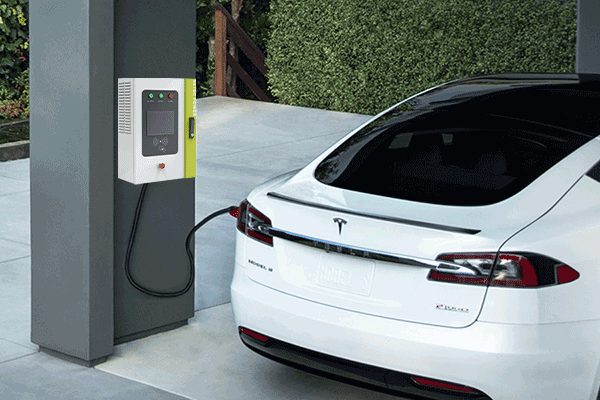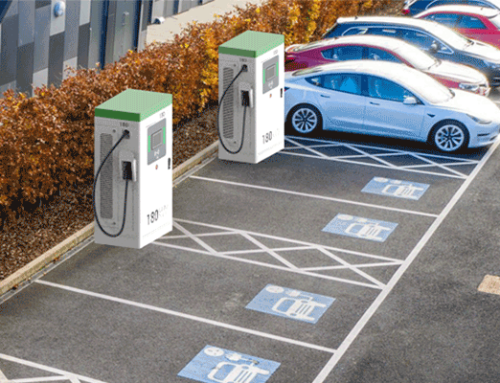Electric vehicles have fundamentally altered our perspective on mobility. With the increasing adoption of EVs, the dilemma of optimal charging methodologies takes center stage. Among the myriad of possibilities, the implementation of a DC fast charger within the domestic sphere presents itself as an alluring proposition, offering unmatched expediency. However, the viability of such a solution merits close examination. Today we’ll provide you with comprehensive insights to inform your informed choices.

What is dc fast charging?
DC fast charging, also known as Level 3 charging, is a top kind of EV charger that charges much faster than the regular chargers we have at home. Unlike the usual AC chargers that you might use at home, DC fast chargers don’t use the car’s own charger but send DC power straight to the EV batteries. This means you can get a lot of miles added to your car in a short charge time – just a few minutes – a really good thing for people with electric cars. Because these chargers are very powerful, usually between 50 kW and 350 kW, and operate at a higher voltage, they are often found at public charging spots or for business use.
However, integrating such powerful chargers into a home environment presents several challenges and considerations, from technical feasibility to financial implications. It’s essential for EV owners to weigh these factors carefully when contemplating a DC fast charger for home use.
Why dc fast charging is not typically viable for home use
Technical Barriers and Limitations
The allure of fast charging at home is undeniable, yet practical technical hurdles exist. First, the electric grid most residential areas are connected to might not support the high power demand of DC fast charging. DC Fast Charging stations typically require a power output ranging from 50 kW to 350 kW. To put that in perspective, a standard home outlet in north America. delivers about 1.8 kW. Essentially, installing a DC Fast Charger at home would be akin to expecting a single household outlet to power an entire street’s Christmas lights — the existing infrastructure simply isn’t equipped to handle such a load.
The issue extends beyond just the capacity of the household wiring. The local electric grid, which supplies power to residential areas, might not be capable of supporting the high demand for electricity that DC fast charging requires. Retrofitting a home to accommodate this technology would not only necessitate substantial changes to the home’s own electrical system, including heavy-duty wiring and possibly a new transformer, but also potentially require upgrades to the local grid infrastructure.
Safety and Infrastructure Challenges
These chargers aren’t just plug-and-play devices. A standard home electrical system is designed to handle a peak load of about 10 kW to 20 kW. The dance of direct current at such high speeds through our homes’ veins carries whispers of safety concerns such as overheating or fire hazards. The infrastructure, not just within our walls but extending to the very grid that cradles our community’s energy, must be robust enough to handle such high amperage power without faltering.
Furthermore, the extensive safety protocols and regular maintenance schedules that public charging stations adhere to are challenging to replicate in a home environment. For instance, a public DC fast charging station is equipped with advanced cooling systems to manage the heat generated during the charging process, preventing overheating. Retrofitting a home to include similar safety measures, alongside the necessary infrastructure upgrades, can be prohibitively expensive.
High Installation Costs
One of the largest hurdles to installing DC fast charging at home is the high cost involved, which extends far beyond simply buying the charger. Let’s break down the costs: installing a 50 kW DC fast charger could easily exceed $20,000 when factoring in the necessary electrical upgrades. These upgrades might include the installation of a new, heavy-duty circuit breaker, robust wiring capable of handling increased electrical loads, and possibly a new transformer to ensure your home can receive and manage this level of power, measured in kilowatts, from the grid.
Moreover, professional installation is non-negotiable due to the complexity and safety standards required, adding to the overall cost. When contrasted with the average cost of installing a Level 2 charger—around $2,000 to $5,000, including minor electrical upgrades—the financial investment in DC fast charging seems disproportionately high for the added convenience it offers. Given these considerations, the high installation costs make DC fast charging an impractical choice for home use for most EV owners.
Practical considerations for home ev charger installation
When considering the addition of an electric vehicle charger to your home, the process involves a myriad of practical considerations that directly influence the installation’s feasibility, complexity, and overall cost. Not all homes are immediately ready or suitable for such an upgrade without significant modifications. From the existing electrical infrastructure of your residence to the type of EV charger best suited to your needs, each factor plays a critical role in determining how smoothly the installation process can unfold. This table outlines the key considerations that homeowners should evaluate before embarking on the installation of an EV charger, thereby ensuring the project aligns with their electrical capabilities, budget, and local regulations.
| Consideration Factors | Impact on Feasibility of Installation |
| Electrical Capacity | Your home must have the necessary electrical service to support the EV charger in addition to your existing electrical load. An insufficient electrical capacity might require expensive upgrades. Note: DC Fast Chargers typically demand power levels beyond residential capabilities. |
| Type of EV Charger | Level 1 and Level 2 chargers are feasible for home installation, requiring different wiring and circuit needs. DC Fast Chargers, while offering the quickest charging times, are generally not feasible for home installation due to their excessive power requirements. |
| Location of the Charger | Wiring length and exposure to weather influence installation costs and complexity for Level 1 and Level 2 chargers. DC Fast Chargers are suited for commercial locations due to their size and power needs. |
| Local Building Codes and Regulations | Regulations and permit requirements affect installation feasibility for all charger types. Compliance with local codes is mandatory. Installing a DC Fast Charger at home is unlikely due to regulatory and practical constraints. |
| Budget | Costs vary widely based on required electrical upgrades, charger type, and labor. |
| Utility Company Requirements | Utilities may have specific requirements or incentives affecting charger choice and costs. The high power requirement of DC Fast Chargers often makes them unsuitable for home use but beneficial for commercial applications. |
Practical options besides dc fast charging at home
Given that setting up a DC fast charger at home isn’t really practical due to high power needs and the significant changes required in home infrastructure, it’s crucial to look into other workable options that still make charging convenient and efficient.
Level 1 Charger
For those in quest of an uncomplicated charging solution, the Level 1 charger, also known as a standard level charger, remains unparalleled. It leverages the ubiquitous 120 Volts alternating current outlet, already available in most homes, thereby eliminating the need for any substantial electrical retrofit. Although it proffers a modest increment of roughly 2 to 5 miles of range per hour of charging, this rate complements the nocturnal recharging regimen of daily commuters perfectly. Importantly, this method promotes a more temperate charging process, potentially prolonging battery life by mitigating thermal strain. The Level 1 charger, which comes with a J1772 or Tesla connector, is a cost-efficient and efficacious selection for EV drivers with regular driving habits and the convenience of overnight charging.
Level 2 Charger
Acting as a bridge between convenience and swiftness, the Level 2 charger represents the good option for residential EV charging. This solution necessitates access to a 240-volt outlet (dryer plug), similar to that required by sizeable domestic appliances, and may occasionally require a minor upgrade to your home’s electrical system. However, this upgrade is significantly less intensive than modifications required for DC fast charging setups. Level 2 charging considerably accelerates the charging process, offering approximately 12 to 80 miles of range per hour. This capability allows an average EV to be fully recharged from depletion in just a few hours, rendering it an optimal solution for EV owners with higher daily usage demands or those in search of an expedient overnight charging solution. Additionally, the potential availability of government or local incentives for the installation of eco-friendly technologies can make Level 2 charging, available in both socket or cable variants, an economically viable option.
Public DC Fast Charging Stations
Public DC Fast Charging Stations offer a compelling solution for those exploring the convenience of DC charging without installing such a system at home. These stations are adeptly engineered to facilitate an expeditious recharge, capable of elevating an EV’s battery capacity from 20% to 80% within the remarkably brief period of 20 to 40 minutes. Thoughtfully positioned in locales that maximize accessibility—such as retail complexes, major travel thoroughfares, and highway service areas—they substantially diminish the interruption to mobility incurred during extensive voyages. While they may not supplant the fundamental role of home charging solutions, these stations are indispensable to the architecture of an all-encompassing electric vehicle charging strategy. They reliably ensure the availability of swift charging capabilities for extended journeys, effectively dispelling concerns over battery endurance and augmenting the utility of EV ownership, particularly for individuals who habitually embark on lengthy travels or find themselves in immediate need of a battery top-up amidst a hectic schedule.
Here is a table for an overview of why these chargers are your best options for home charger:
| Charging Option | Practical Reasons as Alternatives to DC Fast Charging at Home |
| Level 1 Charger |
Requires only a standard household outlet, no sophisticated electrical changes needed.
Offers slow, steady charging (2 to 5 miles of range per hour) ideal for overnight use.
Can extend battery life by avoiding rapid charging stress.
|
| Level 2 Charger |
Offers a faster charging option (12 to 80 miles of range per hour) with minimal electrical upgrades (240V outlet).
Suitable for drivers with higher daily mileage, allowing overnight full battery recharges.
Balances speed and practical modifications for home use.
|
| Public DC Fast Charging Stations |
Provides rapid charging (20% to 80% in 20 to 40 minutes) for on-the-go needs.
Strategically located for convenient access during longer trips.
Complements home charging, especially for those without access to daytime charging.
|
Getting a DC fast charger at home sounds great because it charges fast. But, you need to think about many things like safety, how much it costs, and what you need to set it up. For many people, it’s smarter and more affordable to use a Level 2 charger at home and use DC fast chargers when they are out.
SETEC POWER As the industry-leading manufacturer of electric vehicle charging infrastructure, we offer a variety of solutions for different needs. This can help more people with electric vehicles charge quickly at home. If you are interested in our solution, please contact our professional team immediately. [email protected]














